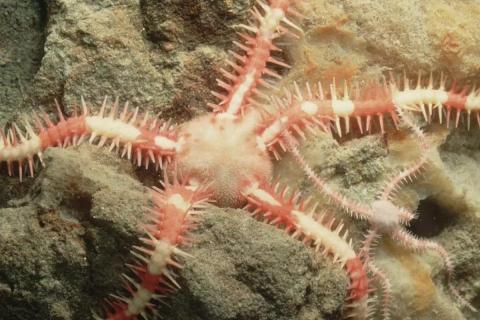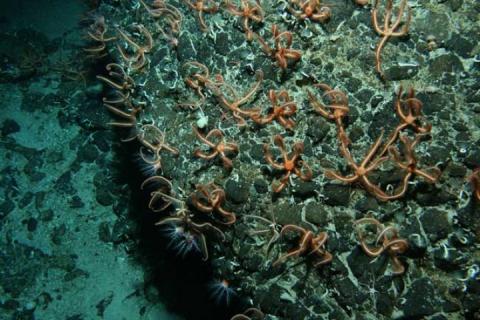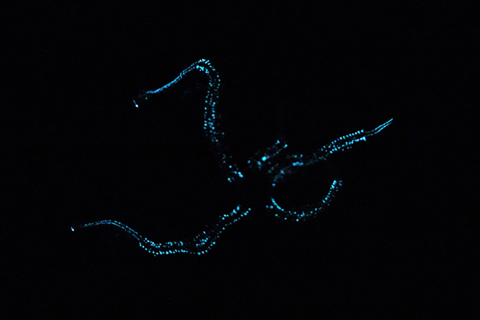
Cousins of the sea stars you see in tidepools, brittle stars live in all parts of the ocean, including the ocean’s deep. They have snake-like arms radiating from their bodies; their Latin name is ophiuroid, meaning serpent tail, referring to the serpent-like arms. There are approximately 2,000 species of brittle star — more than any other group of sea stars.
Brittle stars can be very small (less than an inch across) or can have arms as long as arms which may reach up to 24 inches(60 cm) in length on the largest specimens.
Brittle stars don’t move on tube feet like their sea star cousins, but appear to ‘walk’, as in this video, sometimes called rowing. Any leg can take the lead in movement, that means it’s pretty easy to go in reverse—another arm just takes the lead.
More than half of known brittle star species live in the deep sea, as deep as 11,000 feet. There they live in a diversity of habitats, including on seamounts, muddy abyssal plains, and on top of individual animals, as well as deep-sea coral and sponge reefs. And scientists have even seen them near hydrothermal vents.
Brittle stars may perch on top of underwater mountains, called seamounts, allowing them to feed higher in the surrounding currents, sometimes in large masses. Some of those masses can be extremely dense, such as the ‘brittle star city’ discovered on a seamount in the Antarctic with an astonishing estimate of tens of millions individuals piled-up, arm-tip to arm-tip tens of millions living arm tip to arm tip.

Deep-sea brittle stars feed in different ways: some trap food particles from the water; some feed on organic material on the seafloor as scavengers and detritus feeders; others are active predators that detect prey using chemical and light sensors on their arm tips.
Important in the diverse deep-sea habitats where they live, brittle stars are ecosystem engineers, stirring-up sediment as they dig, recycling nutrients on the seafloor in the process. And they’re important prey of fish and various invertebrates including crabs and sea stars.
Some brittle stars, like so many other deep sea species, make their own light. This is likely to divert predators. Scientists have discovered that brittle stars shed the brightly illuminated tips of their arms when under attack, allowing them to take cover.
The deep sea is largely unexplored and very far away; yet there are threats to it. As access through new technology has increased, explorers have discovered nodules containing manganese, nickel, copper, and cobalt. These metals are valuable to many industries, including for renewable energy and fossil-fuel alternatives – solar panels, wind turbines, electric vehicles, and batteries. There are brittle stars, and countless other creatures living near these nodules.
Mining would destroy these fragile ecosystems.
There is some hope for protection: in early March 2023, nations came together to create a High Seas Treaty that establishes ground rules for conducting environmental impact assessments for commercial activities in the oceans.
Read more about brittle stars.

















